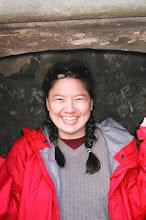Crematogasters: or Why Jack Longino Rocks
 I just received a a large box in the mail from Jack Longino -- my Crematogaster! I am so super impressed with Jack I just spent half an hour trying to put a halo onto a picture of him (to denote his saintliness) but I finally gave up. It was silly. Anyway, he managed to sort the almost 700 specimens I sent him into 19 species (to be completely honest, there were also 1 Azteca, 1 Paratrechina, and 3 Pheidole specimens, none of which look anything like a Crematogaster). And pretty speedily, too. He even included some notes and other helpful information along with each species. Here they are:
I just received a a large box in the mail from Jack Longino -- my Crematogaster! I am so super impressed with Jack I just spent half an hour trying to put a halo onto a picture of him (to denote his saintliness) but I finally gave up. It was silly. Anyway, he managed to sort the almost 700 specimens I sent him into 19 species (to be completely honest, there were also 1 Azteca, 1 Paratrechina, and 3 Pheidole specimens, none of which look anything like a Crematogaster). And pretty speedily, too. He even included some notes and other helpful information along with each species. Here they are:
- limata complex
- Crematogaster carinata. This species is almost certainly more than one cryptic species. The group is found throughout the Neotropics and it is almost always one of the most common species in wet forest areas. There is too much morphological variation for it to be one species, and there are morphological clusters of phenotypes, but they broadly overlap.
- C. levior. This is very similar to and possibly indistinguishable from carinata. The Crematogaster that form big polygynous colonies in ant gardens with Camponotus femoratus are levior. They differ from carinata in having the pronotum completely smooth and shining, with no traces of longitudinal carinae. C. carinata, with more extensive longitudinal etchings or carinae on pronotum may also occur as large polygynous colonies spread through the canopy (they dominate the canopy at La Selva in Costa Rica), but they may also be smaller monogynous colonies here and there, and sometimes parabiotic with other ants like Dolichoderus. C. carinata and levior are two ends of a morphological continuum, so I can't place every specimen cleanly into one or the other. But at the same time there is this pattern, with the ant gardens ones always having shiny pronotum, and non-ant-garden ones having carinate pronotum. In the material you sent I sorted workers into carinata and levior, but I wouldn't put much faith in this. My guess is that there are two or more different species (we always tend to underestimate diversity), and my sort might approximately correspond to two of them, but there will be lots of errors.
- C. brasiliensis. Widespread in Neotropics. Workers not always distinguishable from C. tenuicula.
- C. limata. Widespread in Neotropics. Small workers not always distinguishable from carinata.
- C. tenuicula. Widespread in Neotropics. Always seems less common than brasiliensis, to which it is very similar.
- C. foliocrypta. This is very cool. This species is one I named; previously known only from Costa Rica, where it is rare. There were only two specimens in your batch, and I have kept them here. The Peruvian specimens are lighter yellow brown than Costa Rican material, but other characters match.
- acuta group
- C. acuta. Widespread in Neotropics. Often in more seasonal and open habitats. Never common.
- C. JTL-034. I had to make a new morphospecies code for this one. It is part of a complex of morphospecies, none of which have names, that occur in South America. Very similar species occur elsewhere in Ecuador, in Amazonian Brazil, in Bolivia.
- crinosa group
- C. erecta. Widespread in Amazonian wet forest, extending northward through Panama, to southern Costa Rica.
- C. rochai. Common in dry forest habitats throughout neotropics; rare in wet forest.
- C. crucis. Rare, Costa Rica to Ecuador.
- C. JTL-026. cf. crucis, Colombia and Ecuador.
- C. stollii. Widespread in Neotropics. builds cool carton runways on treetrunks, like termites.
- others
- C. curvispinosa. Widespread in neotropics; small nests in dead sticks, etc. Usually open scrubby habitats or canopy.
- C. JTL-022. Seems to be an Andean species; I have records from Colombia to Peru. Not too common.
- C. sotobosque. Widespread in neotropics. Nests in leaf litter of mature forest, forages on low vegetation.
- C. egregior. Amazonian.
- C. nigropilosa. Widespread in northern Neotropics. Probably a complex of species.
- C. flavomicrops. Widespread, usually in leaf litter, mature forest floor.
Photo: fotopol's flickr account


Just stumbled upon your posting. Jack is my brother and I had to laugh at your indication of his saintliness. Well.......I could offer up some alternative designations...
ReplyDeleteHe is a pretty neat guy, though, most of the time and I am proud to have him for a bro. He used to torture his sisters and mother by putting giant Florida roaches on his bare chest and riding his bicycle around so they couldn't get off. Those were the days.....
Sarah Longino